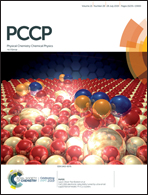Tuning electronic properties of boron phosphide nanoribbons by edge passivation and deformation
Abstract
There is a growing awareness that the structures of boron phosphide (BP) nanoribbons have a significant impact on their electronic transport properties, which will further affect their application in many fields, including energy conversion and nanoelectronic devices. By using the first principle density functional theory and non-equilibrium Green's function calculations, we investigate the electronic transport properties of graphene-like hexagonal zigzag BP nanoribbons with edges terminated by hydrogen atoms (–H) or hydroxyl groups (–OH) and the effect of twisting and bending deformations on their transport properties. Our results show that the electronic transport properties of the BP-H nanoribbons become poor after twisting to 45°, while twisting does not reduce the electronic transport properties of BP-OH nanoribbons. When we combine BP-H and BP-OH nanoribbons into a heterosheet, the effect of twist angle is similar to that for the BP-H nanoribbon. Another interesting finding is that for the BP-OH nanoribbons, there is a significant negative differential resistance (NDR) with a giant peak-to-valley ratio (PVR) of up to 90 when it is curled into an arch, which can be applied as an electric switch. Our detailed insights may provide a novel strategy to tune the electronic transport properties of BP nanoribbon-based structures.

- This article is part of the themed collection: 2019 PCCP HOT Articles


 Please wait while we load your content...
Please wait while we load your content...